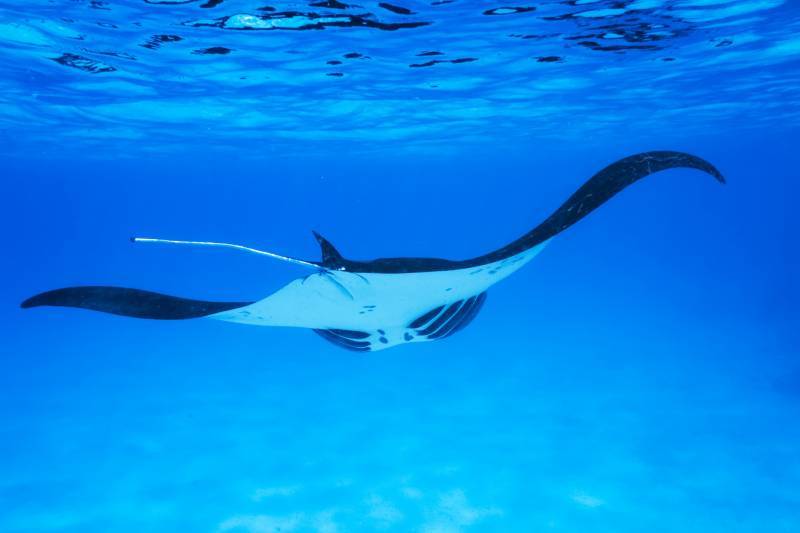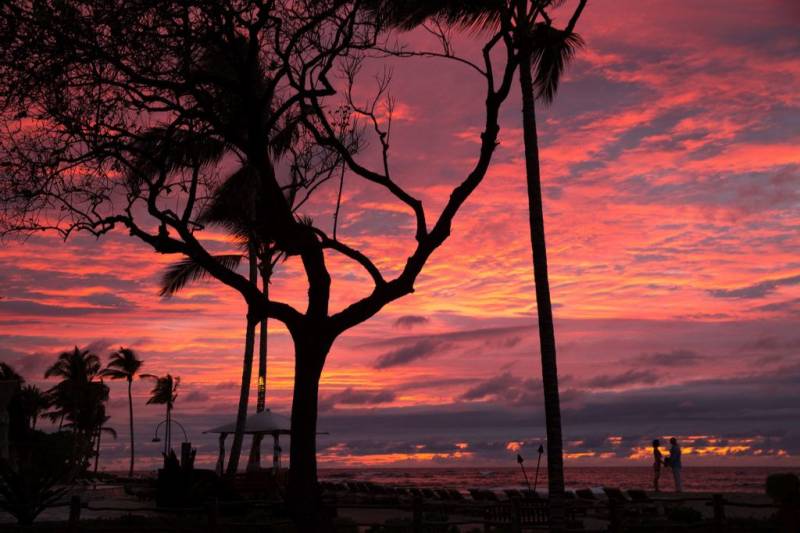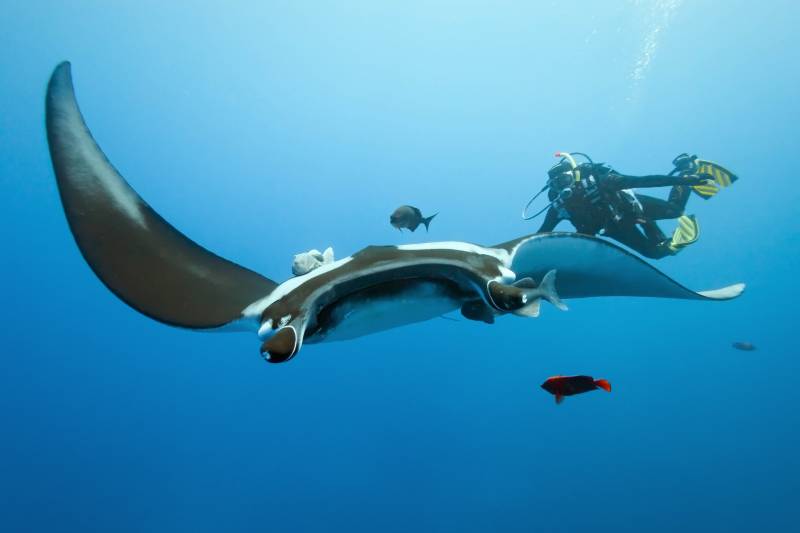Three Ways to Experience Manta Rays at Keauhou Bay on Hawai‘i Island
The Kona Coast of Hawai‘i Island is a haven for wildlife lovers, particularly for those interested in marine life. The area boasts beautiful beaches, as well as some of the deep blue’s more exotic sea creatures. Many of them are easy to spot, as well. Our Hawai’i Island real estate team have spotted groups of spinner dolphins leaping out of the water while standing on the shoreline Kailua-Kona. Naturally, they’ve also seen sea turtles, humpback whales and of course, the graceful Manta Rays.

Retreating Manta Ray
These majestic creatures live in their natural, coastal habitat here in Hawai‘i and are often spotted at two magical locations on the Kona Coast of the Big Island. These sites are known to scuba divers and snorkellers at Manta Village and Manta Heaven. Manta Heaven is located just offshore, close to the Kona International Airport, while Manta Village is about 6 miles south of Kailua-Kona, at the beautiful Keauhou Bay.
Manta rays are related to the shark family, and of course, to other types of rays like Sting Rays and Eagle Rays, yet they are the largest of the ray family. Their wingspan typically reaches up to 15 feet across, though some have been found in other waters with wingspans as large as 25 feet across. Manta Rays can weigh as much as 3,000 pounds and any can live as long as 3o to 40 years, which is a nice, long Hawai‘i life!
While Manta Rays can dive to depths of 700 feet, they typically live at a depth of fewer than 70 feet. Given their size, they have a surprisingly small coastal range of about 90 square miles (30 miles of coastline and about 3 miles offshore). This means that are quite accessible for humans to pay them a visit!
Shoreline Sighting at Rays on the Bay at the Sheraton Keauhou Bay Resort & Spa
While the warm waters off the Kona Coast have long been their habitat, Manta Rays began gravitating to what has now become known as the Manta Village site in the 1970s. Where the shore lights of the hotel (now the Sheraton) illuminate the coastal waters, these Hawaiian Mantas have been coming to feed on their favorite food – marine plankton – which they consume by filtering the food out of the sea water, which they run through their brachial filters. The marine plankton are attracted by the lights, so the hotel and local dive companies provide plenty of it. As a result, thousands of human visitors have also been flocking to this part of Hawai‘i each year to see Manta Rays in their natural habitat – both from the shoreline and from below the surface.

Kona Coast Sunset
Docents at the hotel provide a 20-minute educational talk on Tuesdays and Thursdays at sunset at the hotel’s waterfront restaurant, Rays on the Bay. For a deeper learning experience, visit the Manta Learning Center – which was developed as a partnership between the Manta Pacific Research Foundation and the Sheraton Kona Resort & Spa at Keauhou Bay. Located right next to Rays on the Bay, the learning center brings together the research and expertise of the non-profit organization to help teach kama‘aina and visitors about these hauntingly beautiful creatures. You can learn about their habits, along with how best to interact with these lovely animals in the water, or just a few feet from the shoreline.
Sunset Snorkeling with Manta Rays at Keauhou Bay
While Manta Rays are awe-inspiring and very large, their primary food source is plankton (and not you!) – so they are unlikely to do you any harm. You can also rest assured that plenty of regulation and safety measures are in place and local operators abide by them strictly, in order to ensure the safety of snorkellers, divers, and the Manta Rays themselves. Of course, every reputable snorkel and dive company will brief you about passive interaction with the rays, how to safely enter and exit the water, and more. As a snorkeler, you’ll be warned about keeping your distance and staying on the water’s surface, so as to observe the rays from above. There are designated areas for snorkelers and divers and no free diving is allowed.
Many operators are so familiar with the rays and their habits that they’ve given them charming names like Re-Nata and Sugar Ray. Many help to keep accurate counts of the local ray population and help to study local Manta Ray behavior. There are plenty of reputable operators and a quick google search will help you find one that best suits your needs.

Manta Ray and Diver
Night Diving with Manta Rays at Keauhou Bay
At Manta Village, you’re almost always sure to spot a Manta Ray. While Manta Heaven further to the north sometimes hosts a larger number of rays, the Manta Village dive and snorkel site is known for its consistency. One local dive operator claims that 90% of visitors spot at least one and as many as five manta rays on a typical visit. Naturally, you will need to be a certified scuba diver to partake in a night dive with Manta Rays. Divers meet well ahead of the dive team to leave plenty of room for safety instruction, equipment use, and travel to the site. Divers are asked to rest on the bottom and often, to remove their snorkels so as not to injure the underside of the rays as they pass by. Also, touching the rays is prohibited.
It’s one of the top ten things to do in your lifetime
~The Travel Channel
Again, there are plenty of reputable dive operators to choose from. Some operators offer two-tank dives, so you can dive once before sunset, and then again after dark with the Manta Rays. We recommend this fuller experience and also, it helps to set you at ease with the terrain before you dive into it in the dark. Some will take you to the site in a traditional outrigger canoe, which is without a doubt the most eco-friendly way to go! The dive site is just a short, 10-minute paddle from the edge of the bay, and we imagine this is more peaceful for the Rays, too!
Manta Ray Fun Facts
- The larger rays are usually the females
- The slimy protective coating of a Manta Ray is part of its immune system
- Manta Rays are often called Devil Rays because of their two cephalic “horns”
If living close to the wonder and beauty of Manta Rays is for you, we’d like to suggest some recent blog posts about the Kona Coast lifestyle, some beautiful new construction that’s now being sold at Holua Kai at Keauhou Bay, and some of the area’s many attractions.

A Manta Ray photographed at night in the waters off the Kona coast of Hawaii.

Gisele Albrecht
May 18, 2021
Thanks for a great article! I plan to be in Kona end of Oct 2021 and look forward to a snorkel venture to view these gentle giants! I will also view them at “Rays on the Bay”.
I am so excited to have this experience with Kona’s Manta Rays! ALOHA!